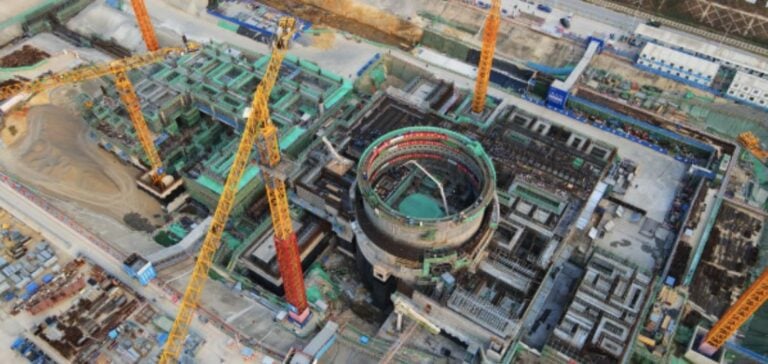The ACP100 Small Modular Reactor (SMR), also known as “Linglong One”, represents a significant breakthrough in China’s nuclear sector.
The project, part of China’s ambitions to increase its nuclear capacity, recently reached an important milestone with the installation of the generator stator at its demonstration site in Changjiang, Hainan province.
The completion of this reactor is planned as part of the country’s goals to achieve 70 GW of nuclear capacity by 2025, underlining China’s commitment to the development of nuclear power. On September 14, 2024, China National Nuclear Corporation (CNNC) announced the successful installation of the generator’s stator, which measures 6 meters in length and weighs over 130 tons.
This complex operation required the use of two cranes to lift the stator through a maintenance lift opening to the steam turbine platform.
The precision required for this installation is particularly high, given the small dimensions of the site.
This milestone marks a crucial step towards completion of the reactor, which is the world’s first commercial land-based SMR.
ACP100 technical features and benefits
The ACP100 is an integrated pressurized water reactor (PWR) with an electrical capacity of 125 MWe.
It is designed for a variety of applications, including power generation, heating, steam production and seawater desalination.
Once operational, the reactor is expected to generate around 1 billion kilowatt-hours of electricity per year, enough to power around 526,000 homes.
In 2016, the ACP100 was the first SMR to pass the International Atomic Energy Agency’s (IAEA) safety review, a testament to its safety and design innovations.
Construction of ACP100 began in July 2019, with the first concrete pour in July 2021.
Equipment installation work began in December 2022, and installation of the external containment dome was completed in February 2024.
The reactor is scheduled to enter service in 2026, after a 58-month construction period.
The ACP100 project is part of China’s wider energy strategy, which aims to reduce its dependence on fossil fuels while increasing the share of renewable and nuclear energy.
Project progress and China’s energy context
The Changjiang site, which is already home to two CNP600 pressurized water reactors in operation, is also under development for two Hualong One units, with commercial operation scheduled to begin by the end of 2026.
The addition of the ACP100 reinforces Changjiang’s role as a strategic center for nuclear development in China.
The project comes at a time when the country is seeking to diversify its energy mix and meet growing energy demand while respecting its environmental commitments.
The successful installation of the ACP100 stator is a major step towards completion of the steam turbine generator unit.
This development underlines the progress towards completion of this innovative project.
As the world’s first commercial land-based SMR, the ACP100 represents a major technological advance for China, which aims to become a world leader in small modular reactors.
Importance and Future Impact of the Project
This project will not only contribute to the diversification of China’s energy mix, but also to the reduction of carbon emissions, by providing reliable and clean energy.
The ACP100 is designed to meet the country’s growing energy needs, while incorporating advanced technologies that enhance safety and efficiency.
The commissioning of this reactor could also serve as a model for other SMR projects around the world, encouraging the adoption of this technology.
The ACP100’s impact on China’s energy landscape is significant.
By integrating modular nuclear solutions, China is positioning itself to meet its energy needs while respecting its commitments to sustainability.
This project illustrates the country’s determination to modernize its energy infrastructure and move towards more sustainable solutions, while maintaining stable economic growth.






















